Research on the Non-Contact Pollution Monitoring Method of Composite Insulator Based on Space Electric Field †
Abstract
1. Introduction
2. Finite Element Simulation Model for Pollution Insulator
2.1. Basic Simulation Settings
2.2. Simulation Model
2.3. Pollution Conditions Setting Method
- (1)
- (2)
- In actual situations, the high-voltage end and the low-voltage end are most likely to produce local arcs. As shown in Figure 2e, this paper simulates two different arc starting stages, namely high voltage end arcing (stage 1), and high and low voltage two-end arcing (stage 2). The local arc is simulated by setting the potential difference on the surface boundary of the insulator shed surface, and local arc bridging regions are simulated with alternating potentials. In order to obtain the value of this potential difference, we need to calculate the voltage of the arc in the simulation using Equation (5). The arc volt–ampere characteristic equation is as follows:where Ua is the peak value of the local arc voltage; I is the peak value of leakage current; La is the arc length; and A and na are arc coefficients, which are associated with environmental parameters. When the composite insulator string starts arcing, the leakage current is not high. According to the recommended value in the literature [25], in this paper, I was set as 10 mA, La was set as 60 mm, A was set as 60, and na was set as 0.35. Under this case, the arc potential was about 1500 V, and this value was used in the computation model to set the boundary potential.
3. Space Electric Field Distribution Simulation Results and Analysis
3.1. Electric Field Distribution of Clean Insulator Strings
3.2. Electric Field Distribution of Insulator Strings under Surface Pollution Wetting Condition
3.3. Electric Field Distribution of Insulator Strings under Dry Band Arcing Conditions
4. Non-Contact Monitoring Method for Contaminated Insulators
5. Artificial Verification Test
- (1)
- Cleaning. The sample was cleaned and allowed to dry naturally.
- (2)
- Polluting. The equivalent salt deposit density, which was set as 0.05 mg/cm2, was simulated by sodium chloride, and the non-soluble deposit density was simulated by kaolin. Their mas ratio was set as 1:6. During polluting of the insulator sample, the surface was firstly covered with a thin layer of kaolin, and then the surface was uniformly brushed to make it evenly coated with a pollution layer, and then the polluted sample was dried in the shade for 24 h.
- (3)
- Evaluating. The sample was hung, the wiring circuit was arranged, the voltage was evenly increased to the rated operating voltage of the insulator, and the ultrasonic fog generator and the fans were turned on. In order to fully wet the surface of the entire series of the sample, the wind direction of the fans went up vertically, and the speed of wind was 2–3 m/s. The arc development on the surface of the sample and the waveform of the oscilloscope were recorded in real time, including electric field signals and leakage current signals. If the flashover did not occur for one hour, the test was stopped. During the test, the arc development was observed and the signal changes recorded by the oscilloscope, and a single rising edge trigger mode was set to intercept the spatial electric field as well as the leakage current waveform at the moment of local arc generation.
6. Conclusions
- (1)
- In the simulation, with the aggravation of the degree of pollution layer wetting and dry band arcing, the insulator spatial electric field amplitude near the low voltage end has an obvious increasing trend.
- (2)
- In the simulation, for the 110 kV composite insulator, it is feasible to identify its pollution layer wetting condition and local arc development through fixed-point monitoring of the spatial electric field signal at a point of d = 0.5 m at the cross-arm, directly facing the last three units of the string.
- (3)
- For the above monitoring locations, the simulation results show that the electric field value is in the scale of 8 kV/m to 22 kV/m under different pollution layer conditions. Compared with clean conditions, the space electric field amplitude increases by 3–43.1% under pollution layer wetting conditions and increases by 83.6–119.4% under local arcing conditions.
- (4)
- The artificial test verified well the proposed method by simulation. Test results show that under different contaminated insulator surface conditions, the change characteristics of the spatial electric field signal are more obvious than the leakage current, which are waveform distortion, fundamental wave amplitude increase, and pulse amplitude increase. Thus, it is feasible to realize pollution flashover warning by monitoring the spatial electric field signal through a non-contact manner.
Author Contributions
Funding
Conflicts of Interest
References
- Yang, Z.; Fan, P.; Wang, Q.F.; Wang, S.W.; Chen, J.; Huang, W.; Wu, B.Q.; Zhou, D. Electric field analysis of internal gaps in composite insulators for high-voltage transmission lines. Power Grid Clean Energy 2019, 35, 1–8. [Google Scholar]
- Zhang, Z.J.; Yang, S.H.; Jiang, X.L.; Qiao, X.H.; Xiang, Y.Z.; Zhang, D.D. DC flashover dynamic model of post insulator under non-uniform pollution between windward and leeward sides. Energies 2019, 12, 2345. [Google Scholar] [CrossRef]
- Majid Hussain, M.; Farokhi, S.; McMeekin, S.G.; Farzaneh, M. Risk Assessment of Failure of Outdoor High Voltage Polluted Insulators under Combined Stresses Near Shoreline. Energies 2017, 10, 1661. [Google Scholar] [CrossRef]
- Majid Hussain, M.; Farokhi, S.; McMeekin, S.G.; Farzaneh, M. Effect of uneven wetting on E-field distribution along composite insulators. In Proceedings of the 2016 IEEE Electrical Insulation Conference (EIC), Montreal, QC, Canada, 19–22 June 2016. [Google Scholar]
- Hao, Y.; Liao, Y.; Kuang, Z.; Sun, Y.; Shang, G.; Zhang, W.; Mao, G.; Yang, L.; Zhang, F.; Li, L. Experimental Investigation on Influence of Shed Parameters on Surface Rainwater Characteristics of Large-Diameter Composite Post Insulators under Rain Conditions. Energies 2020, 13, 5011. [Google Scholar] [CrossRef]
- Wang, S.H.; Tan, G.L. Fuzzy evaluation of insulator pollution flashover based on improved EMD de-noising and entropy weight method. IEEE J. Inf. Comput. Sci. 2015, 12, 5687–5696. [Google Scholar] [CrossRef]
- Ghosh, R.; Chatterjee, B.; Chakravorti, S. A Novel Leakage Current Index for the Field Monitoring of Overhead Insulators Under Harmonic Voltage. IEEE Trans. Ind. Electron. 2018, 65, 1568–1576. [Google Scholar] [CrossRef]
- Majid Hussain, M.; Farokhi, S.; McMeekin, S.G.; Farzaneh, M. Effect of cold fog on leakage current characteristics of polluted insulators. In Proceedings of the 2015 International Conference on Condition Assessment Techniques in Electrical Systems (CATCON), Bangalore, India, 10–12 December 2015. [Google Scholar]
- Chandrasekar, S.; Kalaivanan, C.; Montanari, G.C.; Cavallini, A. Partial discharge detection as a tool to infer pollution severity of polymeric insulators. IEEE Trans. Dielectr. Electr. Insul. 2010, 17, 181–188. [Google Scholar] [CrossRef]
- Ma, Z.B. Research and Design of Online Monitoring and Management System of Insulator Pollution in Distribution Networks in Mining Areas. Master’s Thesis, China University of Mining and Technology, Xuzhou, China, 2019. [Google Scholar]
- Jiang, T.; Wang, J.; He, W.; Yang, F. Non-contact on-line insulators monitoring based on UV-pulse detecting. In Proceedings of the World Automation Congress, Hawaii, HI, USA, 28 September–2 October 2008. [Google Scholar]
- Albano, M.; Waters, R.T.; Charalampidis, P.; Griffiths, H.; Haddad, A. Infrared analysis of dry-band flashover of silicone rubber insulators. IEEE Trans. Dielectr. Electr. Insul. 2016, 23, 304–310. [Google Scholar] [CrossRef]
- Prasad, P.S.; Rao, B.P. Condition monitoring of 11 kV overhead power distribution line insulators using combined wavelet and LBP-HF features. IET Gener. Transm. Distrib. 2017, 11, 1144–1153. [Google Scholar] [CrossRef]
- Jin, L.; Tian, Z.; Ai, J.; Zhang, Y.; Gao, K. Condition evaluation of the contaminated insulators by visible light images assisted with infrared information. IEEE Trans. Instrum. Meas. 2018, 67, 1349–1358. [Google Scholar] [CrossRef]
- Wei, J.C. Research on the Method of Ultraviolet Image Diagnosis of Faulty Insulators and Its Influencing Factors. Master’s Thesis, Shandong University, Shandong, China, 2018. [Google Scholar]
- Zhang, D.; Chen, S. Intelligent Recognition of Insulator Contamination Grade Based on the Deep Learning of Ultraviolet Discharge Image Information. Energies 2020, 13, 5221. [Google Scholar] [CrossRef]
- Qi, B.; Zhao, X.L.; Zhang, S.Q.; Huang, M.; Li, C.R. Measurement of the electric field strength in transformer oil under impulse voltage. IEEE Trans. Dielectr. Electr. Insul. 2017, 24, 1256–1262. [Google Scholar] [CrossRef]
- Arshad; Nekahi, A.; McMeekin, S.G.; Farzaneh, M. Effect of Pollution Severity on Electric Field Distribution along a Polymeric Insulator. In Proceedings of the 2015 IEEE 11th International Conference on the Properties and Applications of Dielectric Materials (ICPADM), Sydney, NSW, Australia, 19–22 July 2015. [Google Scholar]
- Majid Hussain, M.; Farokhi, S.; McMeekin, S.G.; Farzaneh, M. The effects of salt contamination deposition on HV insulators under environmental stresses. In Proceedings of the 2015 IEEE 11th International Conference on the Properties and Applications of Dielectric Materials (ICPADM), Sydney, NSW, Australia, 19–22 July 2015. [Google Scholar]
- Kong, D.S. Experimental Study on Surface Discharge of Silicone Rubber Insulators. Master’s Thesis, Huazhong University of Science and Technology, Wuhan, China, 2016. [Google Scholar]
- Rasara, H.L.; Wong, K.L. Study of electrical field and micro arcing in a wooden supporting structure using Finite Element Method. In Proceedings of the 2012 International Conference on High Voltage Engineering and Application, Shanghai, China, 17–20 September 2012. [Google Scholar]
- Qiao, X.H.; Zhang, Z.J.; Jiang, X.L.; Sundararajan, R.J.; You, J.W. DC pollution flashover performance of HVDC composite insulator under different non-uniform pollution conditions. Electr. Power Syst. Res. 2020, 185. [Google Scholar] [CrossRef]
- Jamshid, M.; Mohammad, M.; Shayegani, A.; Abbas, A. Effect of accumulated surface charges on DC flashover of SiR insulators under pollution and aging conditions. Electr. Eng. 2020, 102, 2123–2133. [Google Scholar] [CrossRef]
- Bhavani, J.; Phani, K.C. Finite Element Modeling of Voltage and Electric Field Distribution along the Insulators. In Proceedings of the 2019 4th International Conference on Recent Trends on Electronics, Information, Communication & Technology, Bangalore, India, 17–18 May 2019. [Google Scholar]
- Jiang, X.L.; Shu, L.C.; Sun, C.X. Power System Pollution and Icing Insulation, 1st ed.; China Electric Power Press: Beijing, China, 2009; pp. 59–124. [Google Scholar]
- Huang, Q.J. Study on Partial Disrcharge On-line Mornitoring of High Voltage Switchgears Based on Ultral-High-Frequency Method. Master’s Thesis, Chongqing University, Chongqing, China, 2013. [Google Scholar]

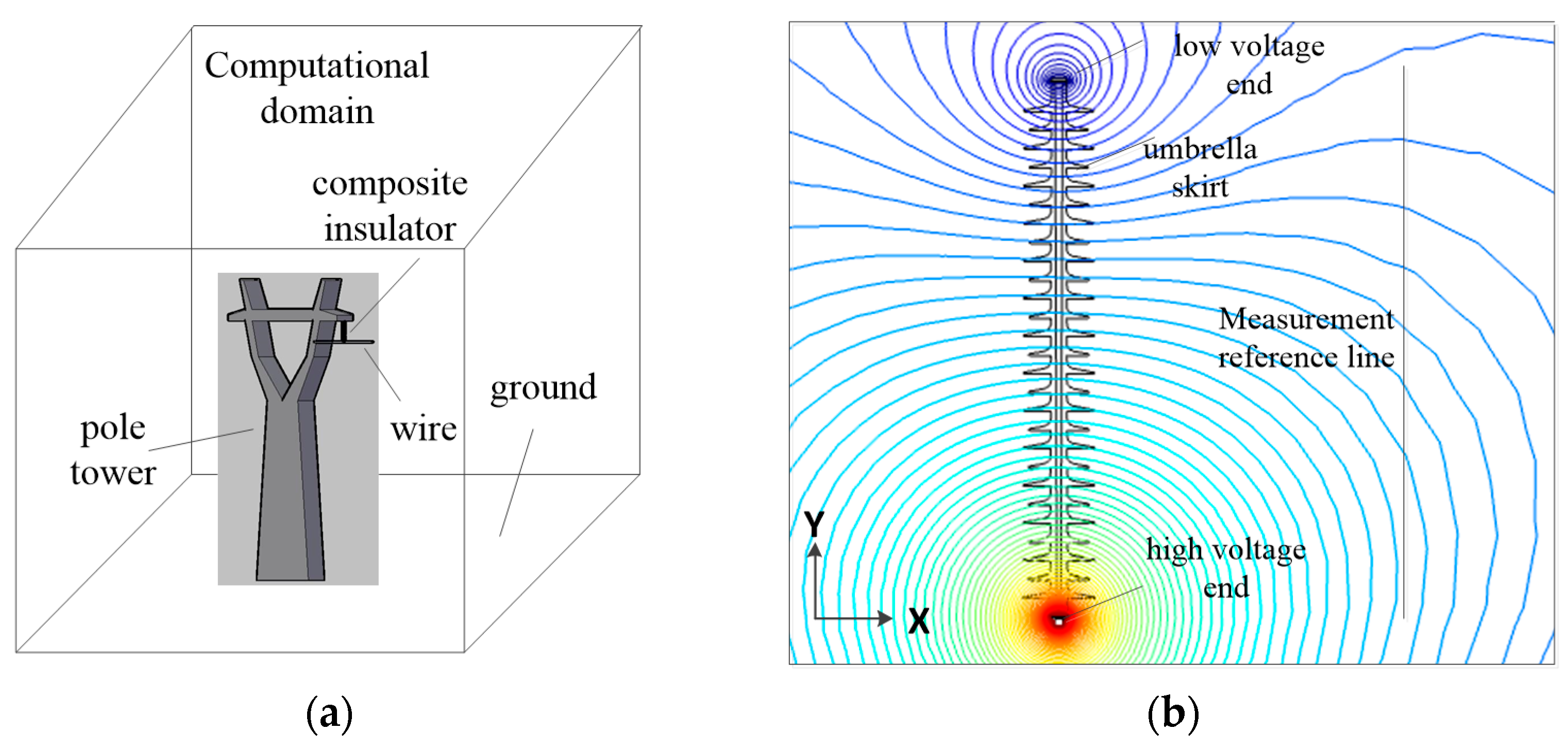
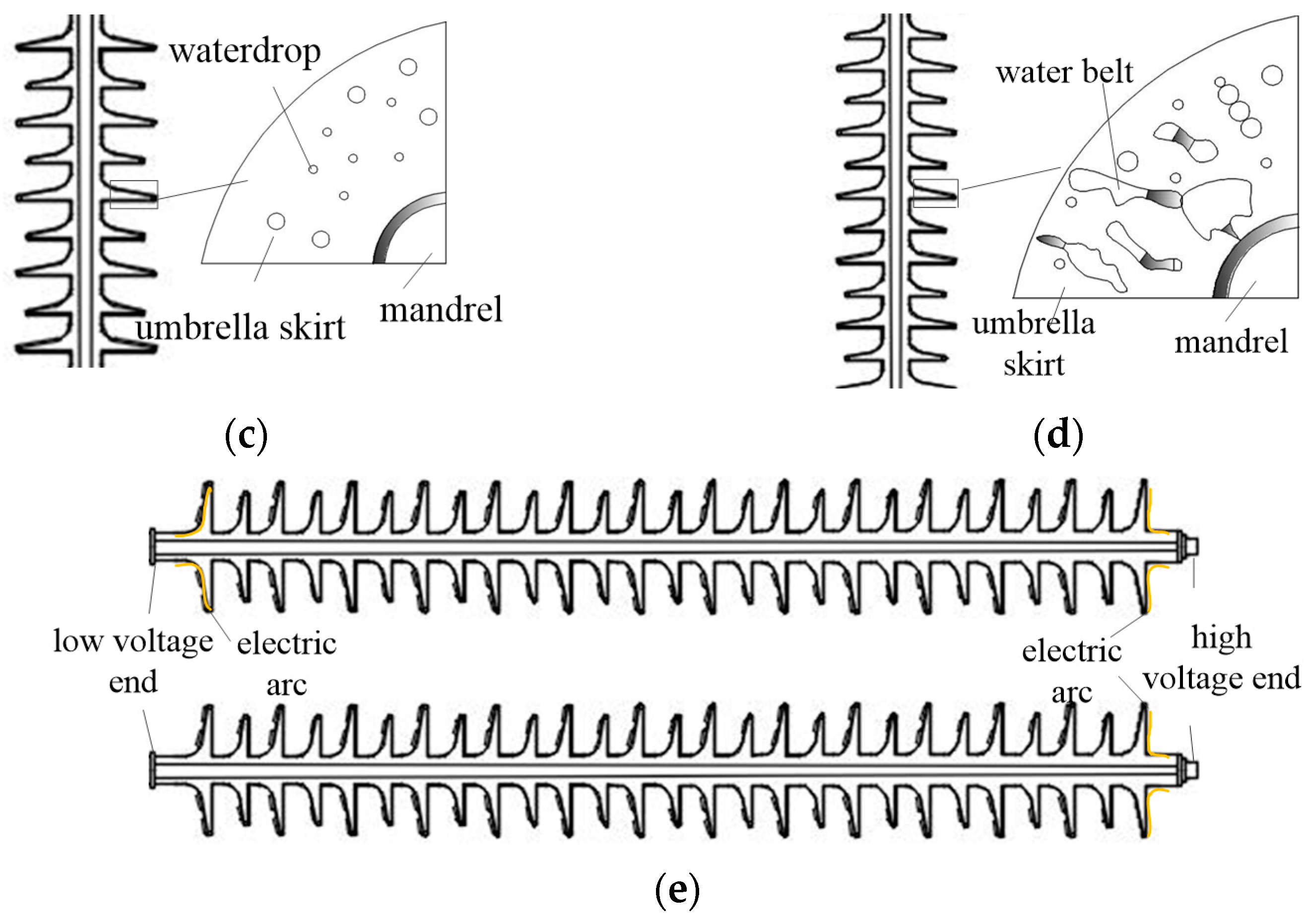

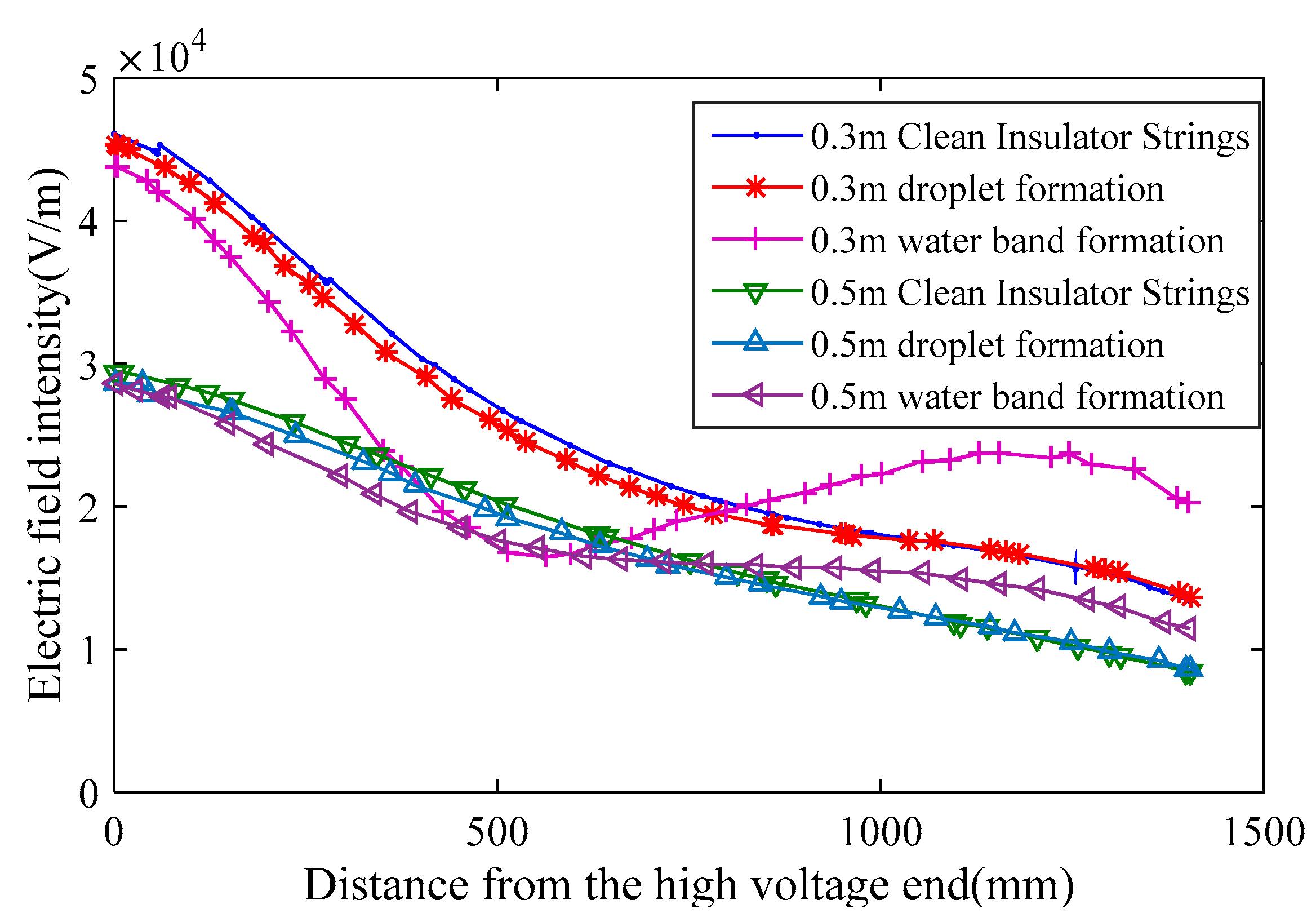

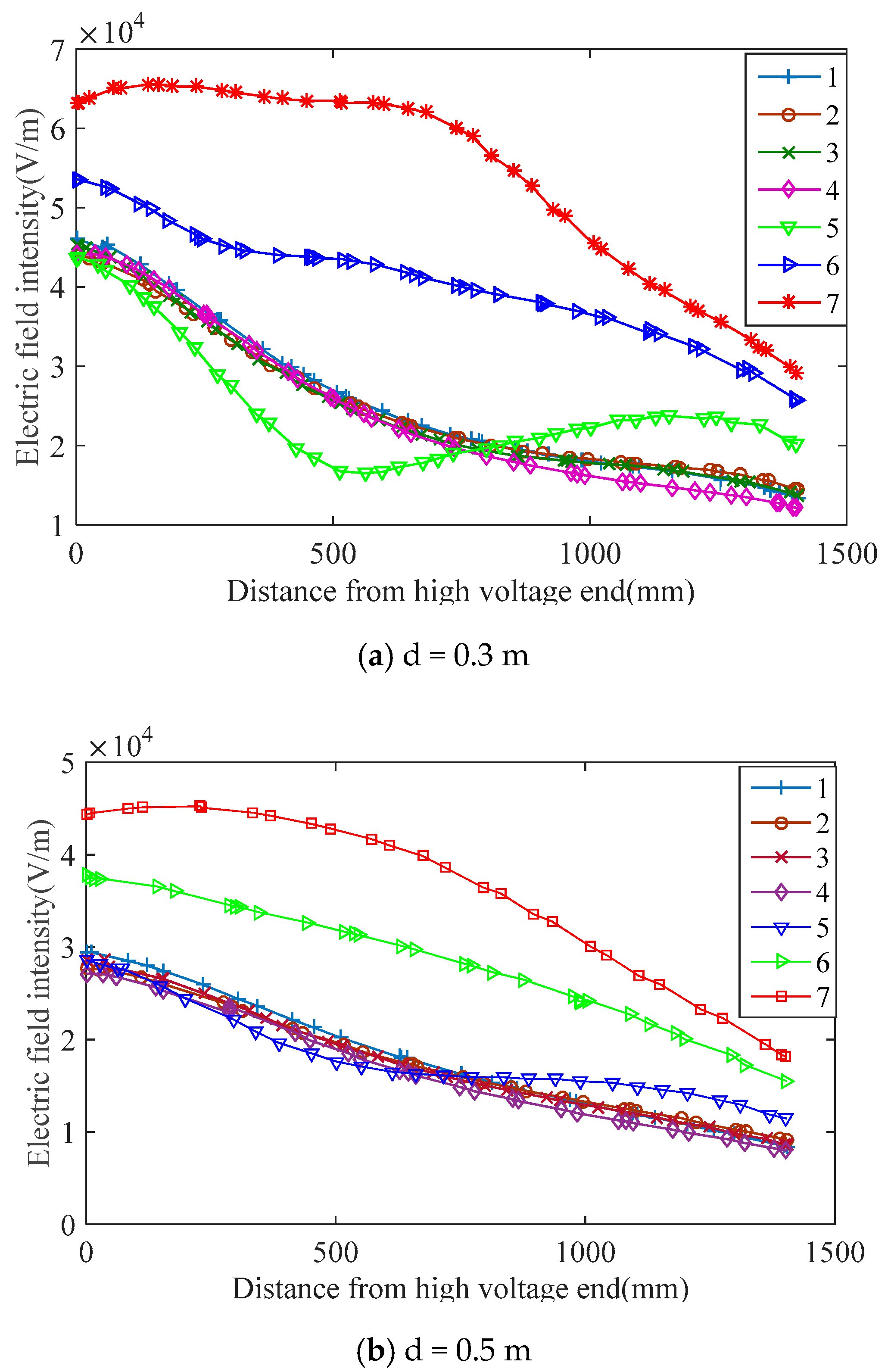
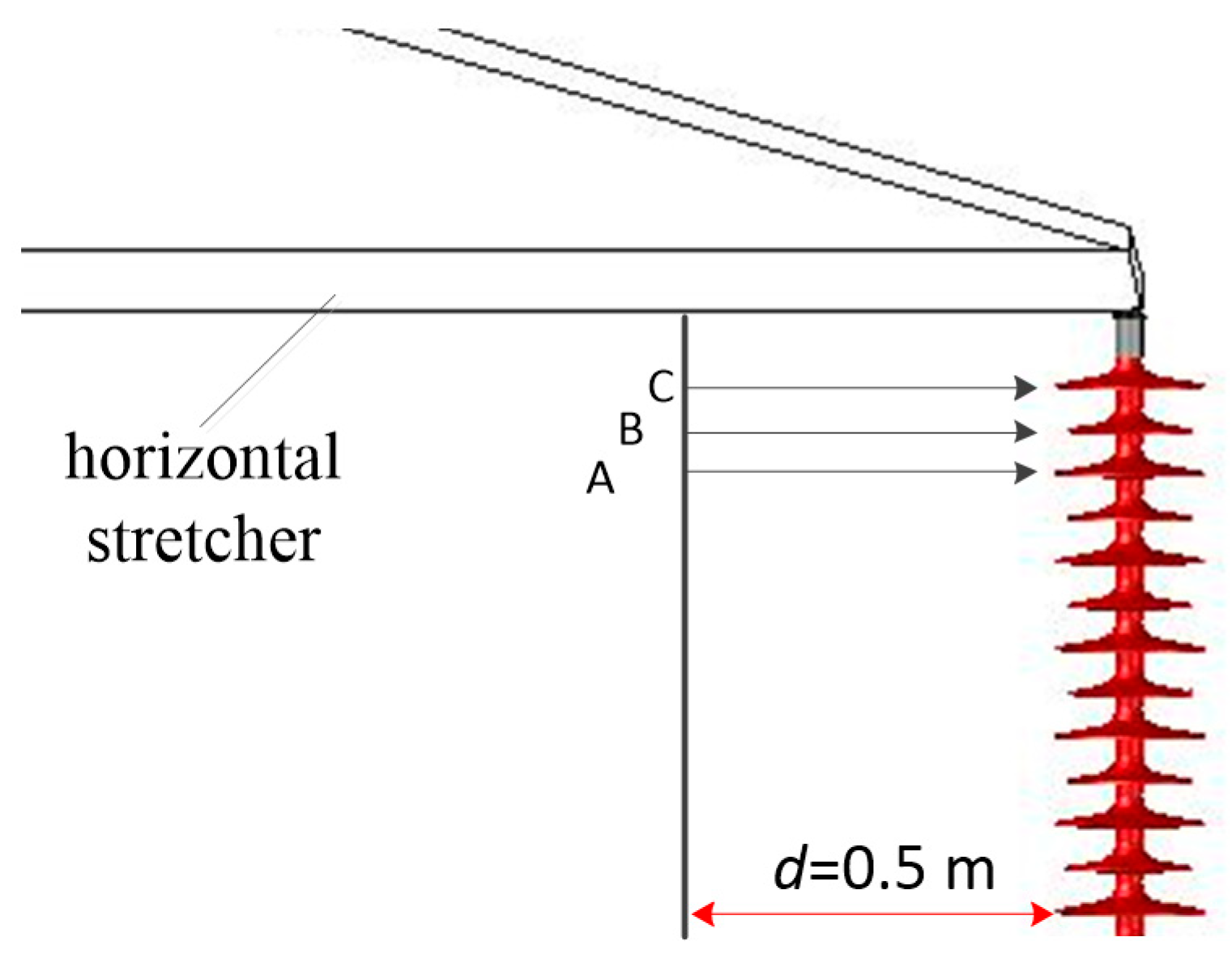
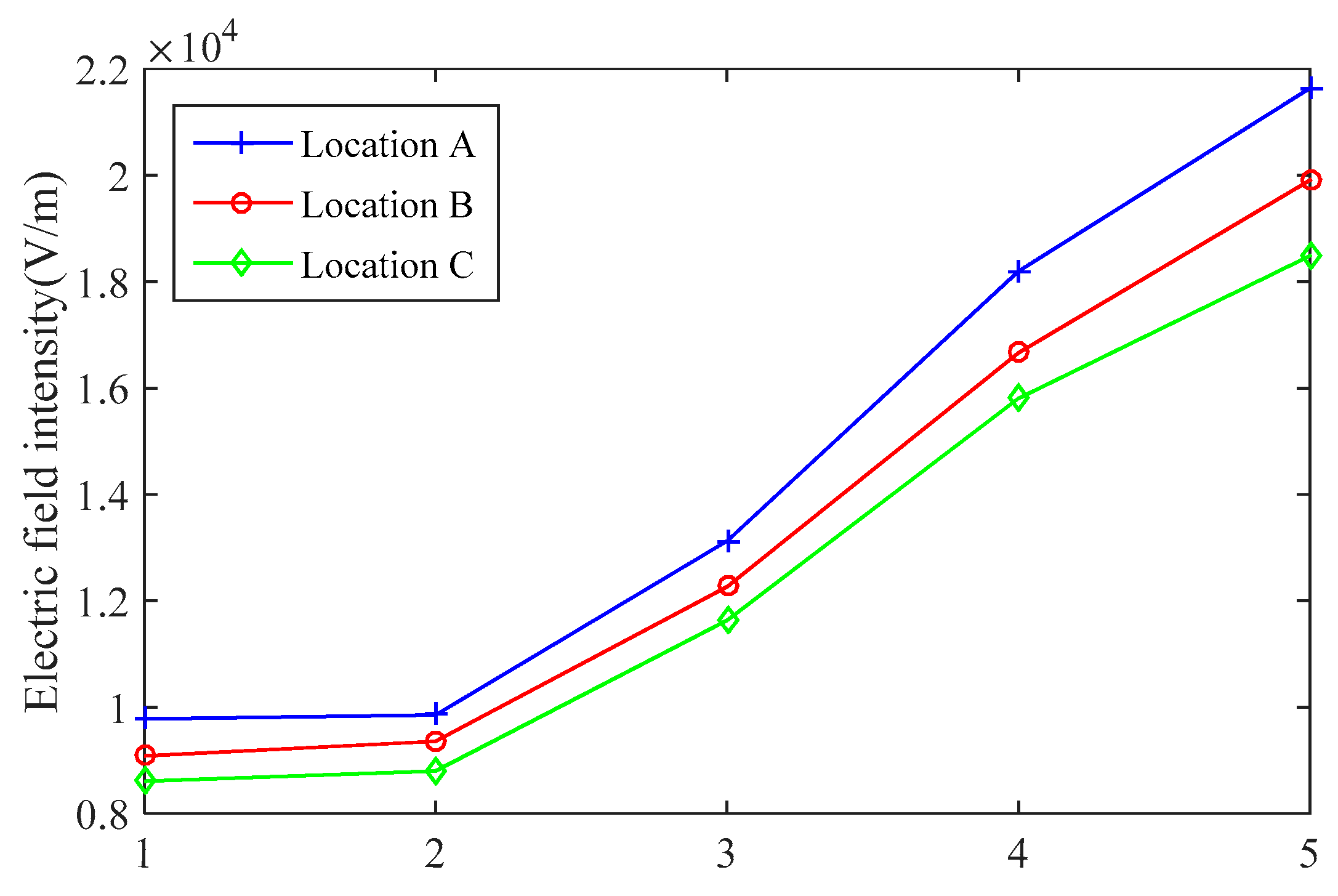

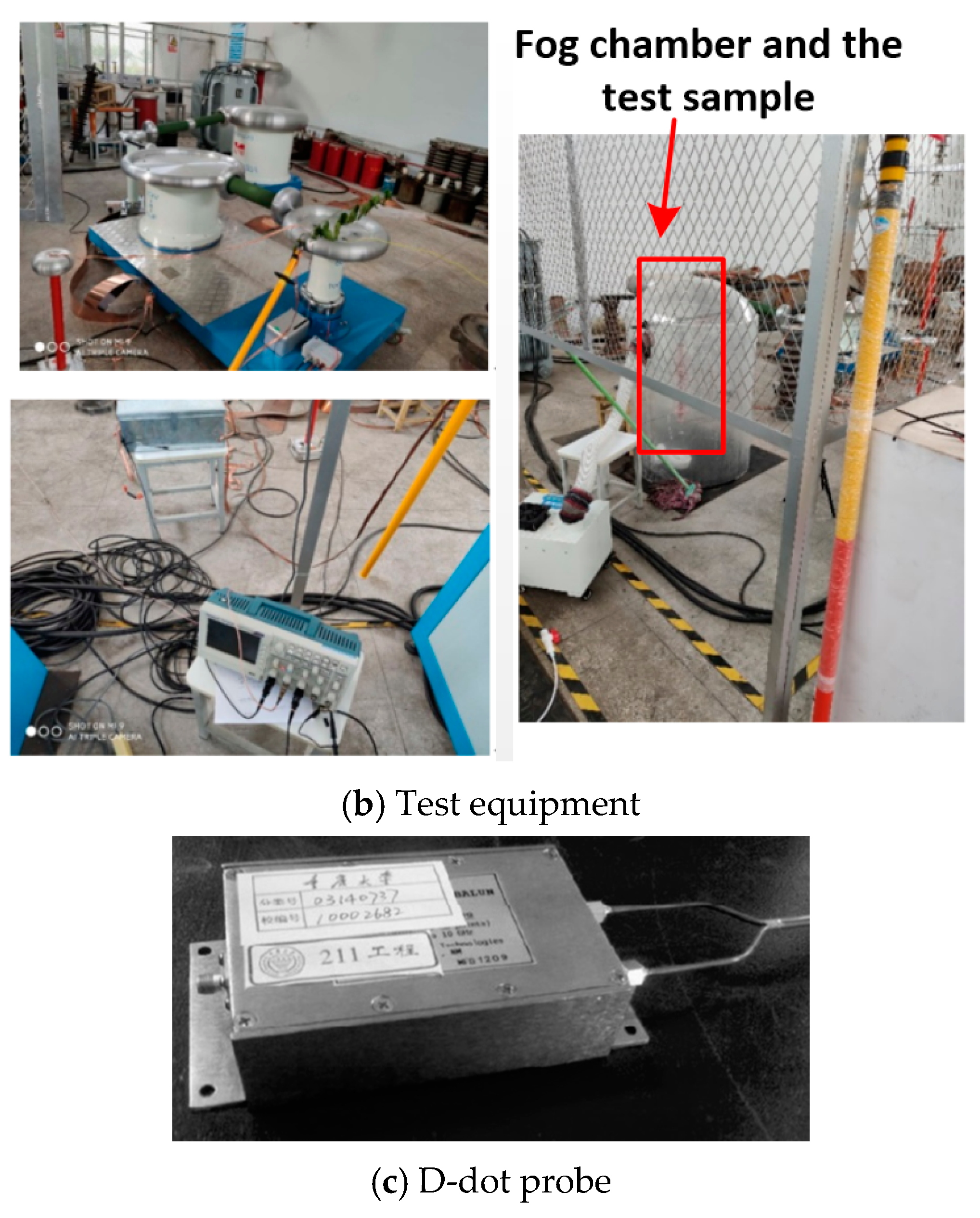

| Type of Material | Relative Dielectric Constant ε | Conductivity (S/m) |
|---|---|---|
| Silicone rubber | 3.5 | 1 × 10−12 |
| Goldsmith | 1000 | 5.998 × 107 |
| Mandrel | 6 | 1 × 10−12 |
| Water droplet/film | 81 | 0.03 |
| Air | 1.02 | 1 × 10−22 |
| Type | Height | Shed Diameter | Creepage Distance | Structure Diagram |
|---|---|---|---|---|
| FXBW-35/70 | 620 | 129/89 | 1280 |  |
| Signal Type | Spatial Electric Field Signal | Leakage Current Signal | ||||
|---|---|---|---|---|---|---|
| Fundamental Wave Amplitude (mV) | Pulse Amplitude (mV) | Variation by l Wave Amplitude | Simulation Results | Fundamental Wave Amplitude (mA) | Pulse Amplitude (mA) | |
| Dry | 20 | 30 | / | / | 1.4 | 2 |
| Pollution layer wetting | 30 | 56 | 33.3% | 3–43.1% | 0.8 | 10–44 |
| Wetting with arcs | 41 | 190–680 | 90.5% | 83.6–119.4% | 3.1 | 16–560 |
Publisher’s Note: MDPI stays neutral with regard to jurisdictional claims in published maps and institutional affiliations. |
© 2021 by the authors. Licensee MDPI, Basel, Switzerland. This article is an open access article distributed under the terms and conditions of the Creative Commons Attribution (CC BY) license (https://creativecommons.org/licenses/by/4.0/).
Share and Cite
Zhang, D.; Xu, H.; Liu, J.; Yang, C.; Huang, X.; Zhang, Z.; Jiang, X. Research on the Non-Contact Pollution Monitoring Method of Composite Insulator Based on Space Electric Field. Energies 2021, 14, 2116. https://doi.org/10.3390/en14082116
Zhang D, Xu H, Liu J, Yang C, Huang X, Zhang Z, Jiang X. Research on the Non-Contact Pollution Monitoring Method of Composite Insulator Based on Space Electric Field. Energies. 2021; 14(8):2116. https://doi.org/10.3390/en14082116
Chicago/Turabian StyleZhang, Dongdong, Hong Xu, Jin Liu, Chengshun Yang, Xiaoning Huang, Zhijin Zhang, and Xingliang Jiang. 2021. "Research on the Non-Contact Pollution Monitoring Method of Composite Insulator Based on Space Electric Field" Energies 14, no. 8: 2116. https://doi.org/10.3390/en14082116
APA StyleZhang, D., Xu, H., Liu, J., Yang, C., Huang, X., Zhang, Z., & Jiang, X. (2021). Research on the Non-Contact Pollution Monitoring Method of Composite Insulator Based on Space Electric Field. Energies, 14(8), 2116. https://doi.org/10.3390/en14082116








